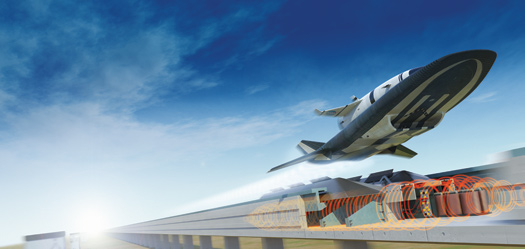

In April, President Obama urged NASA to come up with, among other things, a less expensive method than conventional rocketry for launching spacecraft. By September, the agency’s engineers floated a plan that would save millions of dollars in propellant, improve astronaut safety, and allow for more frequent flights. All it will take is two miles of train track, an airplane that can fly at 10 times the speed of sound, and a jolt of electricity big enough to light a small town.
The system calls for a two-mile- long rail gun that will launch a scramjet, which will then fly to 200,000 feet. The scramjet will then fire a payload into orbit and return to Earth. The process is more complex than a rocket launch, but engineers say it’s also more flexible. With it, NASA could orbit a 10,000-pound satellite one day and send a manned ship toward the moon the next, on a fraction of the propellant used by today’s rockets.
It may sound too awesome to ever be a reality. But unlike other rocket-less plans for space entry, each relevant technology is advanced enough that tests could take place in 10 years, says Stan Starr, a physicist at NASA’s Kennedy Space Center. NASA’s scramjets have hit Mach 10 for 12 seconds; last spring, Boeing’s X-51 scramjet did Mach 5 for a record 200 seconds. Rail guns are coming along too. The Navy is testing an electromagnetic launch system to replace the hydraulics that catapult fighter jets from aircraft carriers. “We have all the ingredients,” says Paul Bartolotta, a NASA aerospace engineer working on the project. “Now we just have to figure out how to bake the cake.”
How To Fly Into Orbit:
Rev Up The Rail Gun
A 240,000-horsepower linear motor converts 180 megawatts into an electromagnetic force that propels a scramjet carrying a spacecraft down a two-mile-long track. The craft accelerates from 0 to 1,100 mph (Mach 1.5) in under 60 seconds— fast, but at less than 3 Gs, safe for manned flight.
Fire The Scramjet
The pilot fires a high-speed turbojet and launches from the track. Once the craft hits Mach 4, the air flowing through the jet intake is fast enough that it compresses, heats to 3,000ºF, and ignites hydrogen in the combustion chamber, producing tens of thousands of pounds of thrust.
Get Into Orbit
At an altitude of 200,000 feet, there isn’t enough air for the scramjet, now traveling at Mach 10, to generate thrust. Here spaceflight begins. The two craft separate, and the scramjet pitches downward to get out of the way as the upper spacecraft fires tail rockets that shoot it into orbit.
Stick The Landing
The scramjet slows and uses its turbojets to fly back to Earth for a runway landing. Once the spacecraft delivers its payload into orbit, it reenters the atmosphere and glides back to the launch site. The two craft can be ready for another mission within 24 hours of landing.
